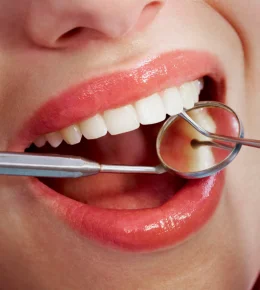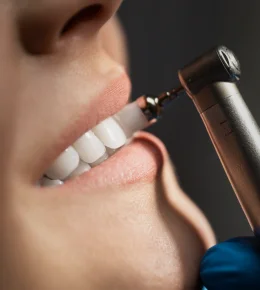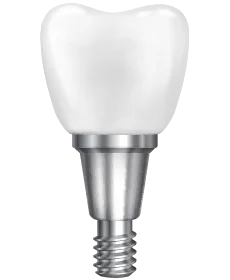Gum treatment
Gum treatment is one of the most important aspects of dentistry, dedicated to preserving and improving gum health. The gums play a crucial role in maintaining the stability of teeth and protecting the underlying structures of the teeth. Issues such as gum inflammation and bleeding, gum recession, and gum infections can lead to more serious problems like tooth mobility, tooth loss, and even jawbone deterioration. To ensure gum health and prevent these issues, gum treatment is of great importance. By regularly visiting a dentist and undergoing necessary treatments, you can take care of the health and strength of your gums and prevent more serious oral problems.

Types of gum treatment
In this process, plaque, stones and other waste masses on the surface of the teeth and the roots of the teeth are cleaned using tools. Then, the surface of the roots of the teeth is leveled in order to improve the attachment of the gums and prevent further inflammations.

Conventional scaling involves cleaning plaque and tartar around the teeth and in the gum walls. This process is done to maintain oral hygiene and prevent inflammation and gum disease.

It is a surgical method that is used to repair and strengthen stretched gums or need strengthening. In this method, healthy gums or special restorative materials are added to damaged or stretched areas to improve the strength and consistency of the gums.

Laser therapy is an advanced method in gum treatment that uses laser beams to provide effective and less invasive treatments for gum problems. This method can be effective in improving bleeding, inflammation of the gums and even improving the general health of the gums.






The stages of receiving services

Search for the service you want or choose from the available services.

In the appointment booking section, select and register your desired appointment.

After searching and registering your reservation, your confirmation will be announced via SMS and you can visit the clinic on the reserved date.
Some of your frequently asked questions
Gum treatment is generally not painful, but some procedures, such as advanced surgeries, may cause temporary discomfort due to bleeding or infection, which is alleviated with pain relievers.
Yes, you can return to your daily activities after gum treatment, including work, exercise and oral care. But you must follow your dentist’s post-surgery instructions.
The results of gum treatment usually depend on the number and type of gum problems you have. In some cases, positive changes such as reduced bleeding and inflammation can be seen within a few weeks, but full recovery may take several months.
Gum treatment can be effective, but it depends on your care and the condition of your teeth and gums. After treatment, maintaining proper oral hygiene and regular visits to the dentist for periodic examinations can help maintain the results.
Yes, but before doing any gum treatment, let your dentist know about your current health problems and recommend the right treatment. These answers will help you become familiar with the important topics of gum treatment. Also, I recommend visiting your dentist for more detailed advice and more information.
All about scaling and gum treatment
- Types of dental scaling methods
- How to measure teeth
- The best time for tooth scaling
- What is dental brosage?
- What is gum flap surgery?
- The most important therapeutic applications of gum flap surgery
- Advantages of gum flap surgery
- Complications of gum flap surgery
- What is tooth crown lengthening?
- Dental crown lengthening surgery procedures
- Benefits of increasing the length of the dental crown
- Complications of increasing the length of the tooth crown
- What is a gum graft?
- Benefits of gum grafting
- Types of gum transplant surgery
- What is gum lift or contouring?
- What are the applications of gum lift?
- Benefits of gum lift
- Disadvantages of gum lift
- Necessary conditions for performing a gum lift
- Types of gum lift
- What are the disadvantages of open sinus lift?
Types of dental scaling methods
In general, there are two methods for scaling teeth:
• Scaling of teeth with manual tools: This method is older and takes about 1-2 hours per session. It is not commonly used today. Except for people who have breathing problems or there is crime in very limited areas.
• Tooth scaling with ultrasonic tools: You have probably all seen this method, it is a dental device called Quaitron or ultrasonic, which has a metal head attached to it and with very small but high number of vibrations, it removes the scale from the surface of the teeth. This process does not cause any damage to the tooth tissue. At the same time as the device moves, water is sprayed, which both washes away the removed masses and prevents the heat transfer of the device to the teeth and gums.
How to measure teeth
The difference between gum scaling and tooth scaling:
What is known as gingival scaling is, in fact, the removal of scale from the teeth but in the subgingival and root areas. At this stage, the particles are removed with the help of the device. Depending on the extent of the crime, it may take one or two sessions to completely remove them. Because the gum is inflamed and swollen due to crime. After the first session, when the gum has healed a little, it recedes and the mass on the root becomes available to be completely removed in the second stage.
The best time for tooth scaling
It is better to perform calculus removal as soon as the calculus is observed on the teeth. And don’t wait for an increase in mass to start treatment. Because the first stages of gum and bone disease are here. In addition, to reduce the need for periodic scaling, be sure to follow the hygiene tips well. Use the right toothbrush and toothpaste and be sure to clean the plaque stuck between the teeth at least once a day with the help of dental floss.
What is dental brosage?
After removing the plaque from the teeth, it is necessary to clean and polish them again with the help of a brush and paste materials that usually contain fluoride. In the tooth brushing process, the remaining stains are removed from the tooth and a completely clean and polished surface remains.
What is gum flap surgery?
When timely action is not taken to treat gum infections and dental problems, bacteria rapidly grow, and the spread of infection in the mouth creates a pocket between the gums and teeth. This empty space, commonly referred to as a gum pocket or periodontitis, significantly predisposes the patient to various types of gum and dental infections. Gum flap surgery is used to address this issue, during which the gum tissue is incised, and cleaning and disinfection procedures are performed.
The most important therapeutic applications of gum flap surgery
1. Reconstruction and repair of gum tissue involved in damage
2. Improvement of gum function
3. Cleaning the gum from infection and bacteria
4. Cleaning the tooth root from infection
5. Eliminating the empty space between teeth and gums
6. Preventing the aggravation of gum disease
7. Restoration of lost bone involved in infection
8. Periodontal restoration
Advantages of gum flap surgery
1. Increasing the beauty of the gums
2. Reducing the risk of contracting other gum diseases
3. Improve smile shape
4. Increasing self-confidence
5. Can be done in a short time
6. Low cost
7. Not having dangerous side effects
8. Simple surgical procedure
Complications of gum flap surgery
1. Light bleeding
2. Swelling and inflammation
3. Feeling pain
4. Analysis and erosion of the gums
5. Increasing the sensitivity of the gums to temperature changes
6. Increasing the risk of tooth decay in the root area
What is tooth crown lengthening?
If the patient’s gums cover the teeth in an abnormal way, or if there is a special problem and accident, and the areas of the teeth below the gums are needed for treatment, the crown lengthening surgery is performed. Lengthening of the crown of the teeth is done by surgery or electrosurgery based on the patient’s condition and doctor’s diagnosis.
Dental crown lengthening surgery procedures
1. Anesthesia ampoule injection
2. Sedative injection if needed
3. Making regular cuts on the gums
4. Removal of excess gum tissue
5. Disinfection of the surgical site with saline
6. Suturing
7. Dressing
Benefits of increasing the length of the dental crown
1. No need for restoration or similar operation
2. Creating a symmetrical smile
3. Increasing the beauty of the face
4. Improving teeth health
5. Reducing the possibility of decay
6. Short duration of surgery
7. Easy and short recovery period
Complications of increasing the length of the tooth crown
1. Tooth and gum infection if caused by the surgeon or lack of care
2. Presence of pain and swelling
3. Gum bleeding
4. Hardening of implant implantation
5. Allergy to hot and cold drinks
What is a gum graft?
Gum grafting is one of the popular therapeutic methods in dentistry that can be used to treat problems caused by gum tissue recession and retraction around the teeth. When the patient’s gum tissue has receded and the roots of the teeth are exposed, gum grafting is performed to create a new covering to protect the tooth roots. Gum grafting can be carried out using various techniques; however, generally, dentists suture a portion of the oral mucosa from the roof of the mouth to the receded gum tissue, allowing the damaged area to heal over time. This treatment method not only prevents complications from gum recession and enhances aesthetics but also reduces the risk of the patient developing other gum and dental problems. Overall, it is considered a safe and effective treatment method.
Benefits of gum grafting
1. Strengthening gum tissue
2. Stabilization of gum tissue on teeth
3. Increasing the beauty of teeth and smile
4. Reducing the possibility of tooth decay
5. Reducing the risk of oral and dental diseases
6. Increasing the beauty of the face and improving the self-confidence of the patient
Complications of gum transplant
1. Mild gum bleeding
2. Swelling of gum tissue
3. Feeling of looseness between the teeth
4. Increased sensitivity of teeth
5. Creating free space between teeth
6. The possibility of infection
Types of gum transplant surgery
In general, gum grafting surgeries are divided into three main categories: flap tissue grafting, free gum grafting, and pedicled gum grafting. Which surgical technique is better and more effective depends entirely on the condition of the gum tissue, jaw bone, and the structure and health of the patient’s teeth. Finally, after a detailed examination, the best treatment method is suggested by the periodontist for gum transplant surgery. In the following, get to know more fully how to perform 3 different styles of gum transplant surgery.
Flap tissue grafting
In this treatment method, the dentist first creates a flap inside the structure of the roof of the mouth to remove a soft tissue from inside the layers of the roof of the mouth, then covers the root of the tooth involved with the complication of gingivitis with the tissue separated from under the highest layer of the roof of the mouth. and sutures, and at the end, he completes the work by creating a soft covering layer on the flap created in the roof of the mouth and suturing it.
Free gum grafting
In the situation where the patient’s gum tissue is not thick enough, the surgical technique of free gum grafting is used. In this treatment method, the periodontist dentist, after examination, separates the required amount of gum tissue from the upper layer on the roof of the mouth, and then the new tissue is inserted into the mouth. Thinned gums are stitched.
Pedicle gingival grafting
Pedicled gum grafting is considered one of the most popular methods of gum graft surgery and is mostly used for patients who have a larger volume and density of gum tissue near the tooth involved in gingivitis. He takes the need and then pulls the gum until it covers the tooth and finally completes the surgical process by suturing.
What is gum lift or contouring?
The place where the gums and teeth join is called the gum line, sometimes due to various reasons such as diseases, genetics, etc. The gum line does not have a symmetrical and principled structure, and this issue leads to an unattractive appearance in the structure of the teeth, and this problem has a negative effect on the patient’s face and self-confidence by reducing the beauty of the teeth.
In gum lift surgery or gum surgery (gingivectomy), the dentist, after performing the necessary examinations and carefully examining the purpose of the treatment, which can be completely medical and therapeutic or even cosmetic, removes the excess gum tissue on the tooth with various methods such as surgery or laser. In dental terminology, this treatment process is called gum lift or gum contouring.
What are the applications of gum lift?
In general, the benefits of gum lift can be summarized in two main topics, i.e. therapeutic and cosmetic applications, sometimes treatment seekers only perform gum lift or gum contouring to improve the appearance of their gums and teeth, but sometimes gum lift is ordered by a dentist with therapeutic purposes. Of course, sometimes gum lift may be done simultaneously to achieve both of these goals.
Enhancing Facial Aesthetics
As previously mentioned, gum lift or contouring is performed not only for therapeutic purposes but also for aesthetic reasons, regardless of any dental issues. In this method of implementing gum contouring, the patient’s gum tissue is modified based on the condition of the gum tissue and the structure of the jawbone and teeth, ultimately improving the shape and appearance of the gum and teeth. The procedure aimed at altering the gum tissue structure to enhance aesthetics is referred to as gingivoplasty.
Benefits of gum lift
Gum lift is considered one of the most attractive miraculous treatment methods in the world of dentistry, which in addition to having many extremely attractive therapeutic functions, has side benefits, including amazing effects on the correction of the structure of the gums and teeth and improving the beauty of the patient’s face. Get to know the most important advantages of gum lift or gum contouring treatment.
The most important advantages of gum lift
1. Treatment of various gum diseases
2. Modifying the structure of gums and teeth
3. Improve self-confidence
4. Creating a beautiful smile
5. Has a permanent result
6. Short treatment duration
7. Short recovery period
8. Appropriate treatment cost
9. Gum alignment
10. Increasing the attractiveness of teeth
11. Reducing the risk of gum disease
Disadvantages of gum lift
Gum lift or gum contouring is considered to be one of the least dangerous treatment methods in the world of dentistry, the probability of the patient being involved with post-treatment complications after the gum lift process is extremely low, but if for any reason gum contouring is fundamentally done by a If it is not done by an experienced dentist, it is possible that you will face a series of possible complications after gum lift.
The most important possible complications of gum lift
1. Increased tooth enamel sensitivity
2. Increased irritability of the enamel
3. Visibility of tooth dentin in case of false gum lift
4. Receding gums if you don’t brush your teeth regularly
5. Bleeding up to 48 hours after the operation
6. The possibility of infection
7. Feeling pain after the numbness wears off
8. The possibility of causing allergies
9. The possibility of failure of the operation and return of the condition of the gums
Necessary conditions for performing a gum lift
1. Gingival erosion due to infection
2. Smallness and narrowness of the upper lip
3. The patient’s involvement with teeth grinding
4. Abnormal genetic low level of gum tissue
5. Having average teeth
6. Strong teeth roots
7. Completing the length of growth of permanent teeth
Types of gum lift
Gum lift or gum contouring is usually done with two different surgical methods or with the help of laser, which treatment method is better and more economical depends on the condition of the patient’s gum tissue and tooth structure, and the best treatment method is different for each patient. and it is possible to diagnose this issue after a detailed examination of the gums and teeth by a specialist dentist.
Gum surgery
Gum lift surgery, which is actually a short-term outpatient surgery, the excess gum tissue is cut by the dentist after injecting anesthesia and taking necessary photographs with a surgical blade, this surgery is considered a more invasive treatment method than laser lift.
Laser gum lift
In the treatment method of gum lift with laser, there is no news about the problems of lift with a surgical blade and… It is not, and the treatment is performed in a shorter period of time with the least pain and side effects. Of course, do not forget that laser gum lift is possible only in situations where we intend to destroy the soft tissue of the gums, that is, it is possible to remove the hard tissues of the gums with a laser. is not
Open sinus lift:
Open sinus lift surgery, which is the classic method of this treatment, is the most common type of sinus lift. All this process is done under local anesthesia or anesthesia.
After cutting the gum and drilling the implant site, the surgeon carefully pushes up the membrane of the sinus floor with a special surgical tool and adds grafting material to this cavity. This should be done very carefully so that the membrane is not damaged. After filling the hole, the wound should be closed with stitches.
After sinus lift surgery, you will wait 4 to 6 months for the complete bone tissue to solidify. Then you can place a dental implant.
Open sinus lift surgery is the only method to increase the volume of the maxillary bone in many situations.
What are the disadvantages of open sinus lift?
The most important drawback of this method is the high number of injuries and complications. After this surgery, there may be a lot of swelling and bruising under the eyes, chin or neck area.
After this surgery, it is necessary to take antibiotics and painkillers for some time.
Closed sinus lift:
The closed technique in the sinus lift causes less damage because there is no need to make a special incision in the gum. In this procedure, all manipulations are done through the hole intended for installing the implant. With the help of special surgical tools, the membrane of the sinus floor is pulled up and an air cushion is created inside it to prevent the membrane from tearing, and then the cavity is filled with bone material.
Closed sinus lift can be performed when the initial volume of the bone is 3 to 4 mm. The implant is then placed (immediately after adding the bone graft). In the closed method, unlike the open method, there is not much bruising and swelling, and the recovery period after the operation is much faster and easier.
What are the disadvantages of closed sinus lift?
The most important thing to consider is choosing a skilled and experienced surgeon to correctly diagnose whether this technique is better for you or a facelift. Some surgeons are more experienced in closed sinus lift and others in open sinus lift.
So the only drawback of this technique is that it may not be done correctly. Due to the limitation in observing the structures behind the jaw, the dentist may mistakenly tear the sinus membrane and as a result the whole operation fails and you have to do it again some time later.
